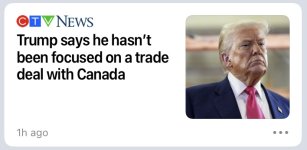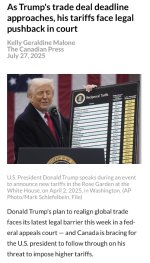Still any doubts as to why Trump preferred Carnage to become PM?Trump wrote an open letter to the prime minister last week, threatening to impose 35 per cent tariffs on Canadian goods starting Aug. 1, vaguely citing as reasons Ottawa’s trade deficit, counter tariffs, dairy trade restrictions, and failure to halt fentanyl from crossing the border. What Trump didn’t do — as he had done with the DST — was outline exactly what Carney needed to do to get things back on track??? On track for what though?
It seems that the more Trump has pushed for concessions from Canada — on defence, on digital taxes, on fentanyl crackdowns — the more he’s been able to get.
U.S.-Canada trade talks back underway as Trump’s wish list, from oil to DEI, keeps growing — National Post
The reasons Trump might have wanted to derail the negotiations — and what other surprises he might have in storeapple.news
Sources say his senior economic team feels they have to sell the president on deal structures, but that Trump often feels he can press for more.
The Tarriff Hype.
- Thread starter petros
- Start date
You are using an out of date browser. It may not display this or other websites correctly.
You should upgrade or use an alternative browser.
You should upgrade or use an alternative browser.
This probably sounds good to clueless and uncaring bureaucraps, however the logistics are not at all easy. BC is currently posing this as a solution to the ongoing softwood lumber disagreement. There are a very few very large lumber producers and hundreds of small producers, with differing types of fiber supply quotas. Almost all large producers are unionized. The majority of small ones are not. We have a socialist government at the moment. Who will get to decide how much each lumber manufacturer gets to export under a quota system?As well as tariffs on goods, the ACI tools include curbs on imports or exports of goods such as through quotas or licences.
Donald Trump’s tariff ultimatums move around a lot, earning him the hated nickname TACO (Trump Always Chickens Out). His latest deadline is to reach trade "deals" (actually, non-binding memoranda, not conventional treaties) with more than 100 countries, including Canada, by Aug. 1.

 apple.news
Any agreement that preserves Trump’s illegal tariffs would lock Canada into a subservient role for many years to come. And there’s no assurance that Trump would even live up to his end (given his regular violations of more comprehensive binding deals, like the Canada-U.S.-Mexico Agreement).
apple.news
Any agreement that preserves Trump’s illegal tariffs would lock Canada into a subservient role for many years to come. And there’s no assurance that Trump would even live up to his end (given his regular violations of more comprehensive binding deals, like the Canada-U.S.-Mexico Agreement).

 apple.news
Of course, lower higher tariffs are better than higher tariffs, and the federal government may try to convince Canadians to accept an imperfect deal on this basis. It’s possible the average tariff on Canadian products under an Aug. 1 deal would be incrementally lower than those being paid by other countries — including those that have already reached "deals," like China (47 per cent), Indonesia (19 per cent), or the U.K. (10 per cent).
apple.news
Of course, lower higher tariffs are better than higher tariffs, and the federal government may try to convince Canadians to accept an imperfect deal on this basis. It’s possible the average tariff on Canadian products under an Aug. 1 deal would be incrementally lower than those being paid by other countries — including those that have already reached "deals," like China (47 per cent), Indonesia (19 per cent), or the U.K. (10 per cent).

 apple.news
This glass-half-full logic is dangerous, however. It’s not just the average tariff rate that determines how much damage will result from Trump’s attacks. The size and composition of trade also matters.
apple.news
This glass-half-full logic is dangerous, however. It’s not just the average tariff rate that determines how much damage will result from Trump’s attacks. The size and composition of trade also matters.

 apple.news
After all, the very structure of our economy has been shaped by a generation of tariff-free trade within North America. As a result, Canada is more dependent on exports to the U.S. than almost any other economy. Our U.S.-bound exports equal more than 25 per cent of total GDP. That means even a seemingly lower effective tariff rate will cause far more damage to Canada than faced by almost any other country. (Only Mexico is in the same boat.)
apple.news
After all, the very structure of our economy has been shaped by a generation of tariff-free trade within North America. As a result, Canada is more dependent on exports to the U.S. than almost any other economy. Our U.S.-bound exports equal more than 25 per cent of total GDP. That means even a seemingly lower effective tariff rate will cause far more damage to Canada than faced by almost any other country. (Only Mexico is in the same boat.)
Trump thinks Canadians 'nasty' for avoiding U.S. travel, banning booze: ambassador — The Canadian Press
Canadians avoiding travel to the United States and banning American alcohol a
Carney says he'll only take 'best deal' from U.S. as premiers disagree over retaliation — National Post
Carney held a meeting with all provincial and territorial premiers during their summer gathering in Muskoka, Ont.
U.S.-Canada trade talks back underway as Trump’s wish list, from oil to DEI, keeps growing — National Post
The reasons Trump might have wanted to derail the negotiations — and what other surprises he might have in store
Opinion | Why a bad deal on tariffs with Donald Trump is worse than no deal — Toronto Star
Any agreement that preserves Trump’s illegal tariffs would lock Canada into a subservient role for many years to come. And there’s no assurance that Trump would even live up to his end.

We win🇨🇦🏆#canada #america #tradewar #tariffs #funny #comedy #skit #snl #sketch #shorts
Enjoy the videos and music you love, upload original content, and share it all with friends, family, and the world on YouTube.
….maybe….That would be something that would have to be planned out, wouldn’t it? Anyway, Donald Trump’s threatened 35-per-cent tariffs on Canadian goods starting Aug. 1 would “most likely” (?) only apply to goods traded outside the United States-Mexico-Canada Agreement currently tariffed at 25 per cent, a U.S. administration official says.

Trump’s 35% tariff threat on Canada will likely exempt USMCA goods, U.S. official says — The Globe and Mail
Official cautions that U.S. President has not yet made a final decisionapple.news
The higher tariffs are “not expected to” (?) cover goods traded under USMCA or oil, gas and potash traded outside the deal, which are currently tariffed at 10 per cent, said the source.
The official, however, cautioned that Mr. Trump had not yet made a final decision and no final paper had been drafted on the subject.
(Today the justification and reasoning isn’t fentanyl or immigration but supply management because it’s Friday maybe?)
I think the deadline is 1 Aug. Better send some Canadian blonde with big tits to suck on his pathetic dick the night of 31 Jul.
 Yeah, I think that dude went back to being just a shop teacher.
Yeah, I think that dude went back to being just a shop teacher.Ummmm. Other than Canada, who else is poised to compete to fill the Russian resources and steel void?
I'll believe that a pipeline will be built when I see it. All talk; no action!
Trump should be thanked by Canadians. It's his policies that have FINALLY gotten our politicians talking about what's good for Canada. It wouldn't have happened otherwise!!
Yep, and Hitler shoulda been thanked by Londoners, for the same reason.Trump should be thanked by Canadians. It's his policies that have FINALLY gotten our politicians talking about what's good for Canada. It wouldn't have happened otherwise!!
Huh? Your weird sense of humor doesn't cut it. Sorry!Yep, and Hitler shoulda been thanked by Londoners, for the same reason.
Got Brits started talking about what was good for Britain, didn't it?Huh? Your weird sense of humor doesn't cut it. Sorry!
ANd what about all the Canadians that earn their living mining potash?
That would be pointless.Got Brits started talking about what was good for Britain, didn't it?
“Aug. 1 is going to come, and we will have most of our deals finished, if not all. We haven’t really had a lot of luck with Canada. I think Canada could be one where they’ll just pay tariffs. It’s not really a negotiation.”

(This’ll benefit the average American?)

Just days before the presumed Aug. 1 agreement deadline, U.S. President Donald Trump said “we haven’t been focused” on reaching a trade deal with Canada. “We don’t have a deal with Canada,” he told reporters Friday morning during a windy outdoor scrum.
“We haven’t really had a lot of luck with Canada. I think Canada could be one where there’s just a tariff, not really a negotiation,” Mr. Trump told reporters Friday as he left the White House for a trip to Scotland. “We don’t have a deal with Canada.”
 On that day, Trump promised, the U.S. will impose a 35 per cent tariff on Canadian goods crossing the border. Those fees could go even higher if Canada further retaliates, etc…’cuz whatever, etc…
On that day, Trump promised, the U.S. will impose a 35 per cent tariff on Canadian goods crossing the border. Those fees could go even higher if Canada further retaliates, etc…’cuz whatever, etc…
The two countries already have a trade deal, the U.S.-Mexico-Canada Agreement. But Mr. Trump wants to supersede key parts of that pact with new provisions that would cut back on American imports of autos, steel, aluminum and other goods from Canada because a countries word is its bond, & who the Hell made that deal anyway?
Canada is also bearing the weight of Trump’s tariffs on steel, aluminum and automobiles, and will be affected by copper duties that are also expected to kick in on Aug. 1 because copper, which America isn’t self sufficient in either.

 apple.news
The negotiations between Washington and Ottawa have also included non-trade-related national security matters, including the border, defence spending, immigration, fentanyl, indigestion, shits & giggles, the 51st state sovereignty trolling, and Mr. Trump’s proposed Golden-ish Dome missile defence system among other come and go issues day to day as needed to distract from the Epstein issue among other US domestic distractions when needed.
apple.news
The negotiations between Washington and Ottawa have also included non-trade-related national security matters, including the border, defence spending, immigration, fentanyl, indigestion, shits & giggles, the 51st state sovereignty trolling, and Mr. Trump’s proposed Golden-ish Dome missile defence system among other come and go issues day to day as needed to distract from the Epstein issue among other US domestic distractions when needed.

(This’ll benefit the average American?)

Just days before the presumed Aug. 1 agreement deadline, U.S. President Donald Trump said “we haven’t been focused” on reaching a trade deal with Canada. “We don’t have a deal with Canada,” he told reporters Friday morning during a windy outdoor scrum.
“We haven’t really had a lot of luck with Canada. I think Canada could be one where there’s just a tariff, not really a negotiation,” Mr. Trump told reporters Friday as he left the White House for a trip to Scotland. “We don’t have a deal with Canada.”
 On that day, Trump promised, the U.S. will impose a 35 per cent tariff on Canadian goods crossing the border. Those fees could go even higher if Canada further retaliates, etc…’cuz whatever, etc…
On that day, Trump promised, the U.S. will impose a 35 per cent tariff on Canadian goods crossing the border. Those fees could go even higher if Canada further retaliates, etc…’cuz whatever, etc…The two countries already have a trade deal, the U.S.-Mexico-Canada Agreement. But Mr. Trump wants to supersede key parts of that pact with new provisions that would cut back on American imports of autos, steel, aluminum and other goods from Canada because a countries word is its bond, & who the Hell made that deal anyway?
Canada is also bearing the weight of Trump’s tariffs on steel, aluminum and automobiles, and will be affected by copper duties that are also expected to kick in on Aug. 1 because copper, which America isn’t self sufficient in either.
Trump says trade deal with Canada may not be reached — The Globe and Mail
His warning follows signals from Prime Minister Mark Carney that the two sides may not be able to reach an agreement by a self-imposed deadline of Aug. 1
Trump hasn't used it as a "Political Weapon"; he's used it for leverage! That's what he does. But, Potash could be the "leverage" for Canada. We'll have to see if its actually implemented properly.ANd what about all the Canadians that earn their living mining potash?
Unfortunately, when it comes to pipelines, which would REALLY be a leverage for Canada, it's a no go unless Carney changes course. His "people" are against pipelines so until I see one that is approved (how when the BC gov't objects) I won't hold my breath & Canada will still be on the losing part of trade & commerce & Canadians will pay the price.
Last edited:
While Trump set an Aug. 1 deadline for countries to make trade deals with the United States, the president's ultimatum has so far resulted in only a handful of frameworks for trade agreements.
Deals have been announced for Japan, Vietnam, Indonesia, the Philippines and the United Kingdom — but Trump indicated last week that an agreement with Canada is far from complete.
"We don't have a deal with Canada, we haven't been focused on it," Trump told reporters Friday. Meh.

The U.S. Court of International Trade ruled in May that Trump does not have the authority to wield tariffs on nearly every country through the use of the International Economic Emergency Powers Act of 1977, so Trump sent a letter to Prime Minister Mark Carney threatening to impose 35 per cent tariffs if Canada doesn't make a trade deal by the deadline. The White House has said those duties would not apply to goods compliant with the Canada-U.S.-Mexico Agreement on trade, etc…

 apple.news
Countries around the world will also be watching as Trump's use of a national security statute to hit nations with tariffs faces scrutiny in the United States Court of Appeals for the Federal Circuit.
apple.news
Countries around the world will also be watching as Trump's use of a national security statute to hit nations with tariffs faces scrutiny in the United States Court of Appeals for the Federal Circuit.
The U.S. Court of International Trade ruled in May that Trump does not have the authority to wield tariffs on nearly every country through the use of the International Economic Emergency Powers Act of 1977.
The act, usually referred to by the acronym IEEPA, gives the U.S. president authority to control economic transactions after declaring an emergency. No previous president had ever used it for tariffs and the U.S. Constitution gives power over taxes and tariffs to Congress.
The Trump administration quickly appealed the lower court's ruling on the so-called "Liberation Day" and fentanyl-related tariffs and arguments are set to be heard in the appeal court on Thursday.
(U.S. government data shows a minuscule volume of fentanyl is seized at the northern border )
)
Deals have been announced for Japan, Vietnam, Indonesia, the Philippines and the United Kingdom — but Trump indicated last week that an agreement with Canada is far from complete.
"We don't have a deal with Canada, we haven't been focused on it," Trump told reporters Friday. Meh.

The U.S. Court of International Trade ruled in May that Trump does not have the authority to wield tariffs on nearly every country through the use of the International Economic Emergency Powers Act of 1977, so Trump sent a letter to Prime Minister Mark Carney threatening to impose 35 per cent tariffs if Canada doesn't make a trade deal by the deadline. The White House has said those duties would not apply to goods compliant with the Canada-U.S.-Mexico Agreement on trade, etc…
As Trump's trade deal deadline approaches, his tariffs face legal pushback in court — The Canadian Press
Donald Trump's plan to realign global trade faces its latest legal barrier th
The U.S. Court of International Trade ruled in May that Trump does not have the authority to wield tariffs on nearly every country through the use of the International Economic Emergency Powers Act of 1977.
The act, usually referred to by the acronym IEEPA, gives the U.S. president authority to control economic transactions after declaring an emergency. No previous president had ever used it for tariffs and the U.S. Constitution gives power over taxes and tariffs to Congress.
The Trump administration quickly appealed the lower court's ruling on the so-called "Liberation Day" and fentanyl-related tariffs and arguments are set to be heard in the appeal court on Thursday.
(U.S. government data shows a minuscule volume of fentanyl is seized at the northern border
Good! I was worried about my supply.(U.S. government data shows a minuscule volume of fentanyl is seized at the northern border)
Isn't it interesting that Trump used tariffs in his first Presidency & nothing like this happened. Huh!While Trump set an Aug. 1 deadline for countries to make trade deals with the United States, the president's ultimatum has so far resulted in only a handful of frameworks for trade agreements.
Deals have been announced for Japan, Vietnam, Indonesia, the Philippines and the United Kingdom — but Trump indicated last week that an agreement with Canada is far from complete.
"We don't have a deal with Canada, we haven't been focused on it," Trump told reporters Friday. Meh.
View attachment 30190
The U.S. Court of International Trade ruled in May that Trump does not have the authority to wield tariffs on nearly every country through the use of the International Economic Emergency Powers Act of 1977, so Trump sent a letter to Prime Minister Mark Carney threatening to impose 35 per cent tariffs if Canada doesn't make a trade deal by the deadline. The White House has said those duties would not apply to goods compliant with the Canada-U.S.-Mexico Agreement on trade, etc…
Countries around the world will also be watching as Trump's use of a national security statute to hit nations with tariffs faces scrutiny in the United States Court of Appeals for the Federal Circuit.
As Trump's trade deal deadline approaches, his tariffs face legal pushback in court — The Canadian Press
Donald Trump's plan to realign global trade faces its latest legal barrier thapple.news
The U.S. Court of International Trade ruled in May that Trump does not have the authority to wield tariffs on nearly every country through the use of the International Economic Emergency Powers Act of 1977.
The act, usually referred to by the acronym IEEPA, gives the U.S. president authority to control economic transactions after declaring an emergency. No previous president had ever used it for tariffs and the U.S. Constitution gives power over taxes and tariffs to Congress.
The Trump administration quickly appealed the lower court's ruling on the so-called "Liberation Day" and fentanyl-related tariffs and arguments are set to be heard in the appeal court on Thursday.
(U.S. government data shows a minuscule volume of fentanyl is seized at the northern border)